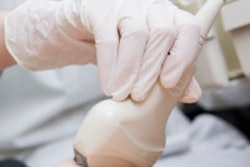A new study has found that women admitted to the emergency department for acute pelvic pain may be receiving more imaging exams than needed. Many diagnoses are made based on the initial imaging study and additional exams are unnecessary, the authors say.
A research team from Stony Brook University Medical Center evaluated 408 women who had received multiple imaging studies to evaluate emergent acute pelvic pathology. The group found that 37% were diagnosed based on the first imaging study. In those cases, additional scans served only to confirm the diagnosis of the initial study.
"Once a diagnosis is made based on imaging, further imaging is likely unnecessary," said Dr. Elizabeth Buescher, a fourth-year resident. "If you've ordered additional tests, you can probably cancel them. And ordering multiple imaging studies simultaneously gives more information faster, but it's probably an unnecessary use of healthcare dollars."
Buescher presented the findings at the recent American Institute of Ultrasound in Medicine (AIUM) meeting in New York City.
Between March 1, 2009, and March 1, 2010, 408 women presented to the emergency department (ED) or were admitted to Stony Brook University Medical Center with acute pelvic symptoms and pain. They received multiple pelvic imaging studies (sonogram, CT with or without contrast, and MRI with or without contrast) in the first 24 hours. Women who received only abdominal imaging were not included.
The researchers determined how many imaging studies were needed to make the final diagnosis. Of the 408 women, 399 (97.8%) had two studies. Eight women had three studies, and one woman had four.
A diagnosis was made based on the first study in 152 (37%) patients, on the second study in 104 (23%) patients, and on the third study in one (0.12%) patient. No diagnoses were made based on a fourth study.
"Interestingly, the one woman who had four studies was diagnosed on her first scan," Buescher said.
In addition, 163 (40%) patients were not diagnosed based on the imaging results, and the majority of these patients were discharged with a diagnosis of abdominal pain, NOS (not otherwise specified). One patient was sent home but then admitted three days later with a renal infarct that was too new to be seen on initial imaging studies, she said.
Sonography was the first study ordered in 238 patients, while CT was the first study in 168. MRI was the first exam in two patients. Sonography was the second study ordered in 168 patients, and CT was the second study ordered in 229. MRI was the second exam in 11 patients.
In patients who received a third imaging study, two received sonography, five had a CT study, and one underwent MRI. In the 152 patients who were diagnosed with the initial imaging study, 90 had a CT first that was diagnostic for their ultimate pathology.
"Those 90 patients went on to have an ultrasound, which based on the current price of an ultrasound in Long Island resulted in an extra expenditure of over $47,000," Buescher said.
The majority of those patients had gynecologic pathology such as ovarian cysts or fibroids, she said. In seeking to determine why additional imaging studies were ordered, the researchers determined that the studies were often ordered at the same time or mere minutes apart, according to Buescher.
"This would suggest that the physician who ordered them both at the same time wasn't quite sure what was going on, and was hoping that pictures, one way or the other, would help them out," she said.
The researchers also found that ovarian cysts diagnosed on CT scans almost always resulted in a sonogram to further elucidate the nature of the cyst.
Sixty patients had an ultrasound first, which was diagnostic. Those patients then had a CT for an extra cost of $130,500. As was the case with the CT-first patients, many of these CT studies were ordered at the same time as the initial study.
"And sometimes it appears that physicians caring for the patient did not think that the imaging was consistent with what they thought [was causing] the pain," she said.
Final diagnoses included 111 ovarian cysts, 27 fibroids, 26 other gynecologic pathology, 23 appendicitis cases, 17 other pathology, 14 other gastrointestinal pathology, 13 primary mesenteric adenitis, 12 nephrolithiasis, 10 diverticulosis, seven colitis, and six other urinary pathology.
Simultaneous orders?
In examining the time between studies, almost 40 patients had their studies less than an hour apart, and 18 had their exams less than 20 minutes apart. One patient even had two studies a few seconds apart, Buescher said. The majority, though, were two to three hours apart.
Time analysis of the patients implies that many studies are being ordered simultaneously. The institution's ED has experienced rapid growth in its patient population, and there's a lot of pressure on the ED to get patients in and out faster, she said.
"Ordering studies at the same time might be the result of those pressures," she added.
A delay in patient care and treatment might also result if patients are sitting in the hallway or waiting room waiting for additional studies, according to Buescher.
While data analysis is still ongoing, the researchers concluded that once a diagnosis is made, there is often no need for further confirmatory studies. They did note exceptions in a few rare cases in which patients had two pathologies diagnosed from different scans, such as a kidney stone found on CT and ovarian cysts detected on ultrasound.
"If you have a high clinical suspicion that something is going on beyond what your imaging study shows, obviously you should investigate that further," she said.
The number of imaging studies ordered in the ED has risen dramatically over the past decade, and patients are often being imaged unnecessarily, Buescher said.
"Appropriate imaging studies are not always ordered first," she said. American College of Radiology (ACR) guidelines should be followed when ordering imaging studies.




.fFmgij6Hin.png?auto=compress%2Cformat&fit=crop&h=100&q=70&w=100)




.fFmgij6Hin.png?auto=compress%2Cformat&fit=crop&h=167&q=70&w=250)











